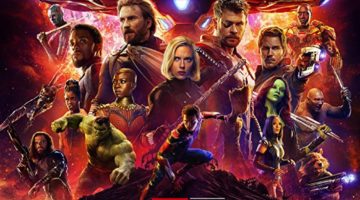
Photo courtesy of AntMan3001/Flickr. Poster for the 2019 Marvel film, “Captain Marvel”. As Marvel Studios’ first woman-led film, it stealthily analyzes the consequences of war violence on certain communities and issues of xenophobia, while also portraying sexism in a realistic way.
Marvel Studios has always done an exceptional job with analyzing social issues in their stories.
In “Captain Marvel”, the latest installment of Disney’s Marvel film universe, Vers (played by Brie Larson) is a member of the Starforce — a military team made up of an alien race called Kree. Vers is a tenacious yet emotion-driven soldier, with unique powers that draw from an energy source from within her, making her much stronger and powerful than her peers. However, Vers has no recollection of her life besides her last six years with Starforce and is constantly told to control her strong emotions by her higher-ups, Yon-Rogg (Jude Law) and the Supreme Intelligence (Annette Bening).
While on a mission, the Starforce infiltrates a small band of shapeshifters called Skrulls, and Vers is taken hostage in one of their vessels headed for Earth. Aboard the ship, the Skrulls probe her mind for information, allowing her to see brief glimpses of her life as an Airforce pilot before being drafted into the Starforce. After crash-landing and escaping the Skrulls, Vers runs into a younger Nick Fury (Samuel L. Jackson) and Agent Phil Coulson (Clark Gregg). The year is 1995. Soon, Vers discovers details about her past and present that change everything she knows about war and the Starforce, thus leading her to fulfill her role as Captain Marvel.
This high-action, dynamic story unfolds relatively slowly, which is something to be appreciated. The easy pacing allows viewers to absorb intricate details of a story that extends beyond just heroes and villains. While uncovering her past, Captain Marvel discovers information about the effects of war violence on certain alien races, and how her perception has been distorted by her involvement with the Starforce.
This plot seems to be an analysis of current war politics and social views on foreign cultures. U.S. Americans are often taught to fear other ethnicities by exaggerating and criminalizing major cultural differences, leading to xenophobia, racism and violence against different cultures within the country. These ideas about foreign cultures are especially instilled in the U.S. through the education system, media, government policies and more. However, like Captain Marvel, many of us realize these ideologies are not true as we grow older, meet new people and are exposed to different points of views outside what we’ve been taught.
Besides the poignant messages in the film, there are also a great number of details in motion graphics and special effects. It’s no secret that Marvel does an amazing job with makeup as well. In this film especially, various alien races are so well-established in appearance, their cultures often shine through in their clothing, makeup and mannerisms. Scenes in space are especially jaw-dropping, per usual with Marvel films.
Captain Marvel’s powers are also portrayed so elegantly — even when she isn’t so elegant in using those powers herself. Her character development is incredibly well-done, which is most likely attributed to the fact that two out of the three people in charge of the film and screenplay were women. The film frequently focused on injustices Captain Marvel faced with sexism growing up, and how her strength as a woman influenced her ability to lead and empathize with others. Not only that, but the movie also focuses on her relationship with Airforce pilot and former best friend, Maria Rambeau (Lashana Lynch). Rambeau and her daughter are two other figures in the film that prove how resilient, steadfast and fierce women can be, and how much they can get done in positions of power.
The only negative thing to be said about this film is that some scenes were down-right corny. While the film was hilarious throughout, certain moments balanced on the verge of being cringe-worthy, yet they usually didn’t last long and were typically forgotten by the following scene. Overall, the film deserves four out of five stars.
Carla can be reached at csuggs@nevadasagebrush.unr.edu, or on Twitter @carla_suggs.












